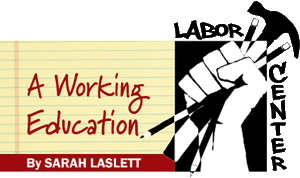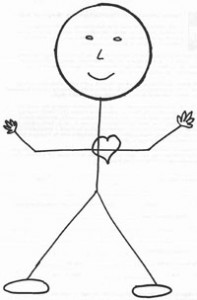OPINION
Head, Heart, Hands & Feet: Exercise your union solidarity
 (May 21, 2014) — Solidarity is the watch-word of the labor movement, and it is a wonderful concept. Standing shoulder-to-shoulder — raising our voices together — fighting for the greatest good for the greatest number. Labor history is chock full of inspiring stories about workers struggling together in solidarity with both hopeful and painful results.
(May 21, 2014) — Solidarity is the watch-word of the labor movement, and it is a wonderful concept. Standing shoulder-to-shoulder — raising our voices together — fighting for the greatest good for the greatest number. Labor history is chock full of inspiring stories about workers struggling together in solidarity with both hopeful and painful results.
But these days, for many of us, solidarity has become too much of an abstraction. If you haven’t been on a picket line or part of an organizing drive, you might have only a shadowy notion of what solidarity really is and, what’s more, what solidarity DOES. This is where it gets really amazing. Acting in solidarity changes people. It makes us braver and smarter, more caring and compassionate, more willing to work at relationships (even with people we don’t like), and more willing to take action (even when there is risk involved).
So how can union members and leaders whose organizations don’t currently have a culture of solidarity come to understand the nature of solidarity and, more importantly, use it as a guide for winning campaigns? Below is a step-by-step description of an exercise called Defining Solidarity: Head, Heart, Hands & Feet that your group can do together to help answer this question. Give yourself plenty of time — at least an hour — to do this work together.
If this exercise seems daunting, or you need a little inspiration to get started, come to the MayWorks Wrap Celebration at South Seattle College (Olympic Hall – 6000 16th Ave SW, Seattle) on Saturday, May 31 at 5:30 p.m. We will be premiering the new video Solidarity Stories that the Labor Center is producing as part of our Workers’ Rights Manual project. We will also be announcing the winners of the WSLC We Do the Work video contest, showing the videos, and awarding prizes! Come out to support and be inspired by the creativity and spirit of working people! There will also be a wine & cheese reception. Hope to see you there!
Defining Solidarity: Head, Heart, Hands & Feet
 1) On a flip chart sheet (a large piece of paper) use markers to draw figures (one per sheet) that have heads, hearts, hands & feet and post them on the walls. Don’t worry if they aren’t accurate or even artistic. They could even look as silly as this one on the right.
1) On a flip chart sheet (a large piece of paper) use markers to draw figures (one per sheet) that have heads, hearts, hands & feet and post them on the walls. Don’t worry if they aren’t accurate or even artistic. They could even look as silly as this one on the right.
2) You can do this exercise with a large group (up to 30). As you begin, keep in mind the overall mission and goals of your organization. Brainstorm together a list of your key relationships, both inside and outside of your organization. This can include relationships among your staff and leaders, with your members, or with outside allies or stakeholders who have an interest in your mission. Examples: If your group is working on education reform, your relationships would be with students, teachers, parents, administrators, state agencies, school staff and teachers’ unions, etc. If you are gearing up for contract negotiations, your key relationships will be among the bargaining unit members, union leaders (especially the bargaining committee), other, similarly situated unions, supportive community-groups, etc.
3) After the brainstorm, break your large group into pairs or small teams and assign each of them one key relationship to work on. Each team gets a stick figure and markers.
4) Each team should discuss and identify IN CONCRETE TERMS what the nature of solidarity is within the specific key relationship they have been assigned. Further, they will consider four categories that focus on different aspects of the relationship:
► Head: The Intellectual aspect. What information do people need to know? Example: For your education campaign, what do parents need to know about standardized testing?
► Heart: The Emotional aspect. What feelings do people have about the issue? Example: How to parents feel when their children are inspired by a good teacher?
► Hands: The Relational aspect. Who works together (well or poorly)? Example: Is there one great school principal who really gets what you are trying to do? How, as an education leader, can she support your campaign and how can you support her work?
► Feet: The Action aspect. What do you need your allies to DO? Example: Attend a school board meeting and testify.
5) As the teams do their work, they should write notes on their stick figure’s head, heart, hands and feet. These notes should reflect their discussion about what they think is most important about these various aspects of the solidarity relationship. They may find that, because of the particular relationship they are focusing on, one or another of these aspects is most important. If so, the groups can enhance that part of the body. For instance, the solidarity relationship with policy makers might have a really big head! You can even add pieces to the figure like, maybe, ears for listening, or good walking shoes for marching. Give the teams at least 20 minutes to do this work.
6) Finally, each team reports back to the large group. By thinking deeply about these key relationships through the lens of solidarity, your group will have generated a lot of concrete ideas on which to base a campaign driven by solidarity!
If you have labor education questions or topics that you’d like to see addressed in future Working Education features, email me at sarah.laslett@seattlecolleges.edu.
Sarah Laslett is Director of the Washington State Labor Education and Research Center at South Seattle College. Her column — “A Working Education” — is a regular feature of The Stand. Learn more about the Labor Center here.





